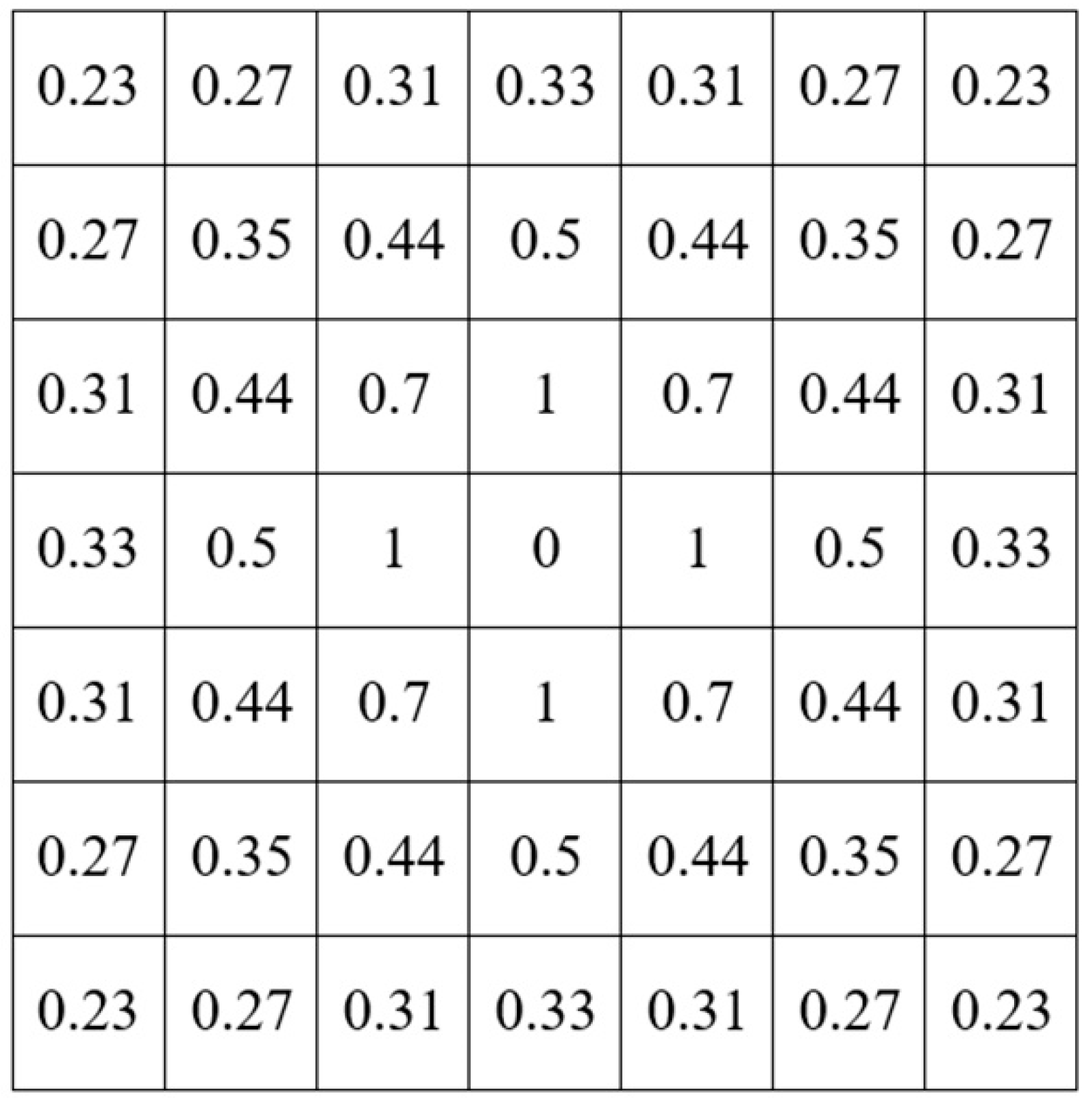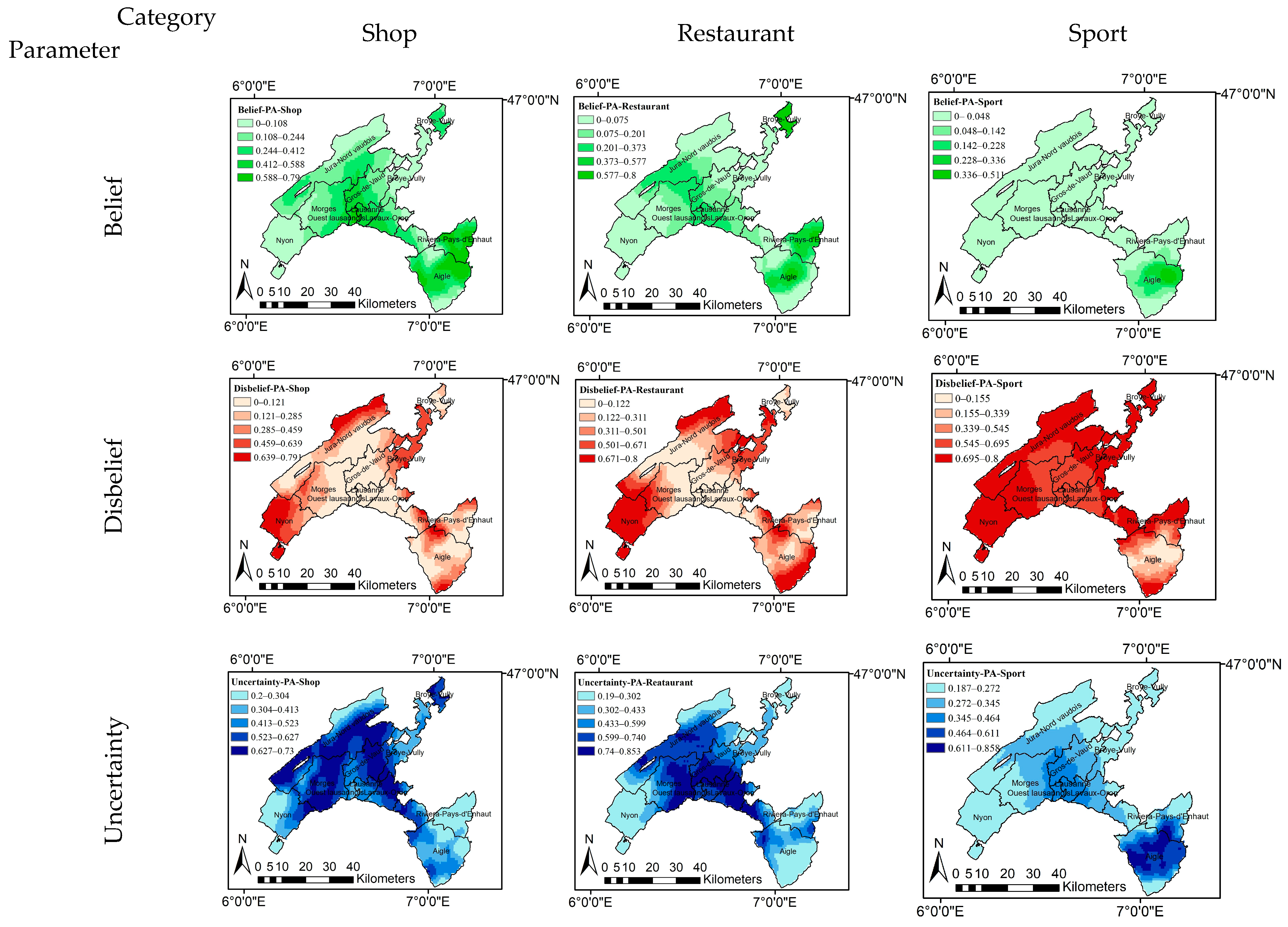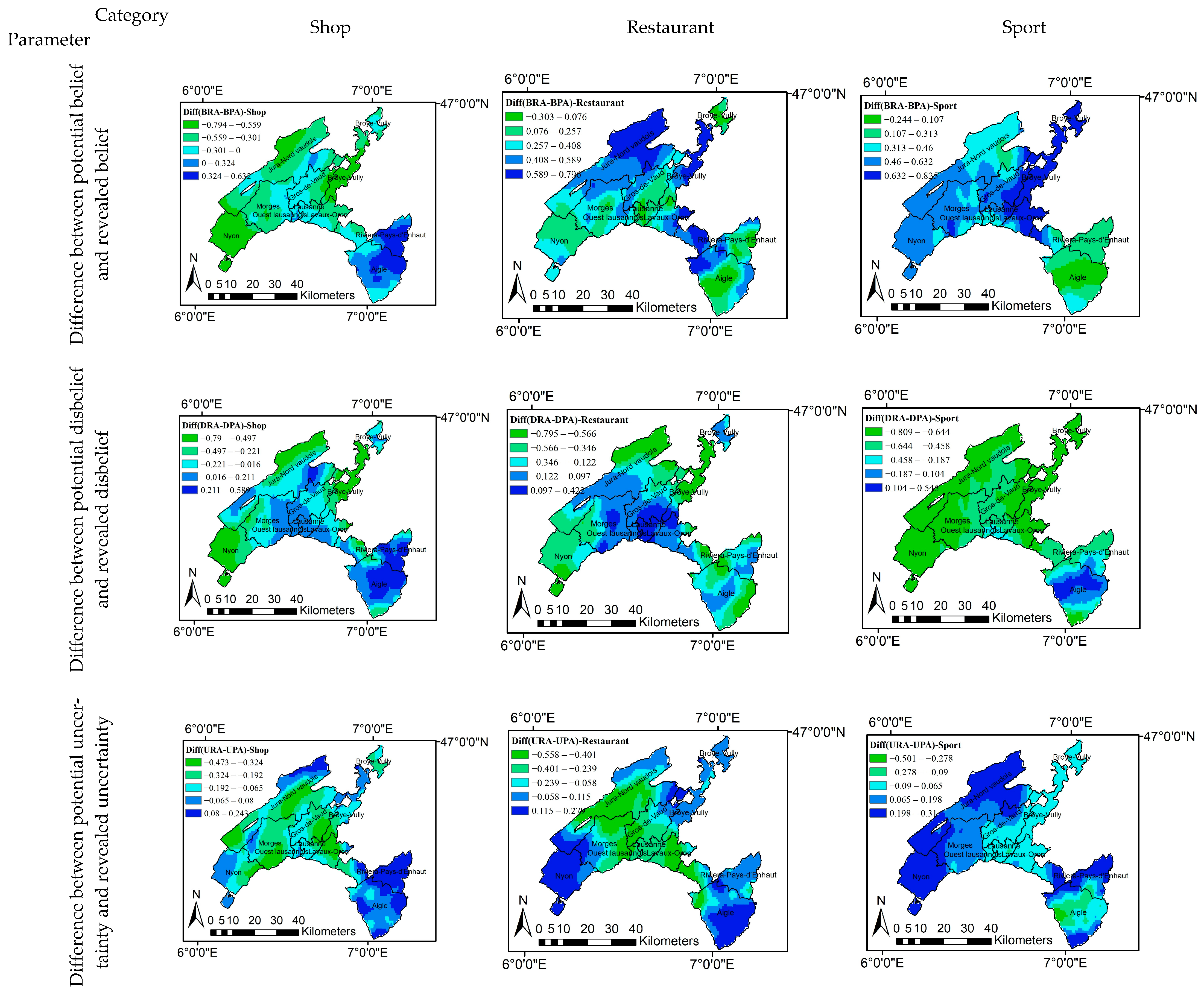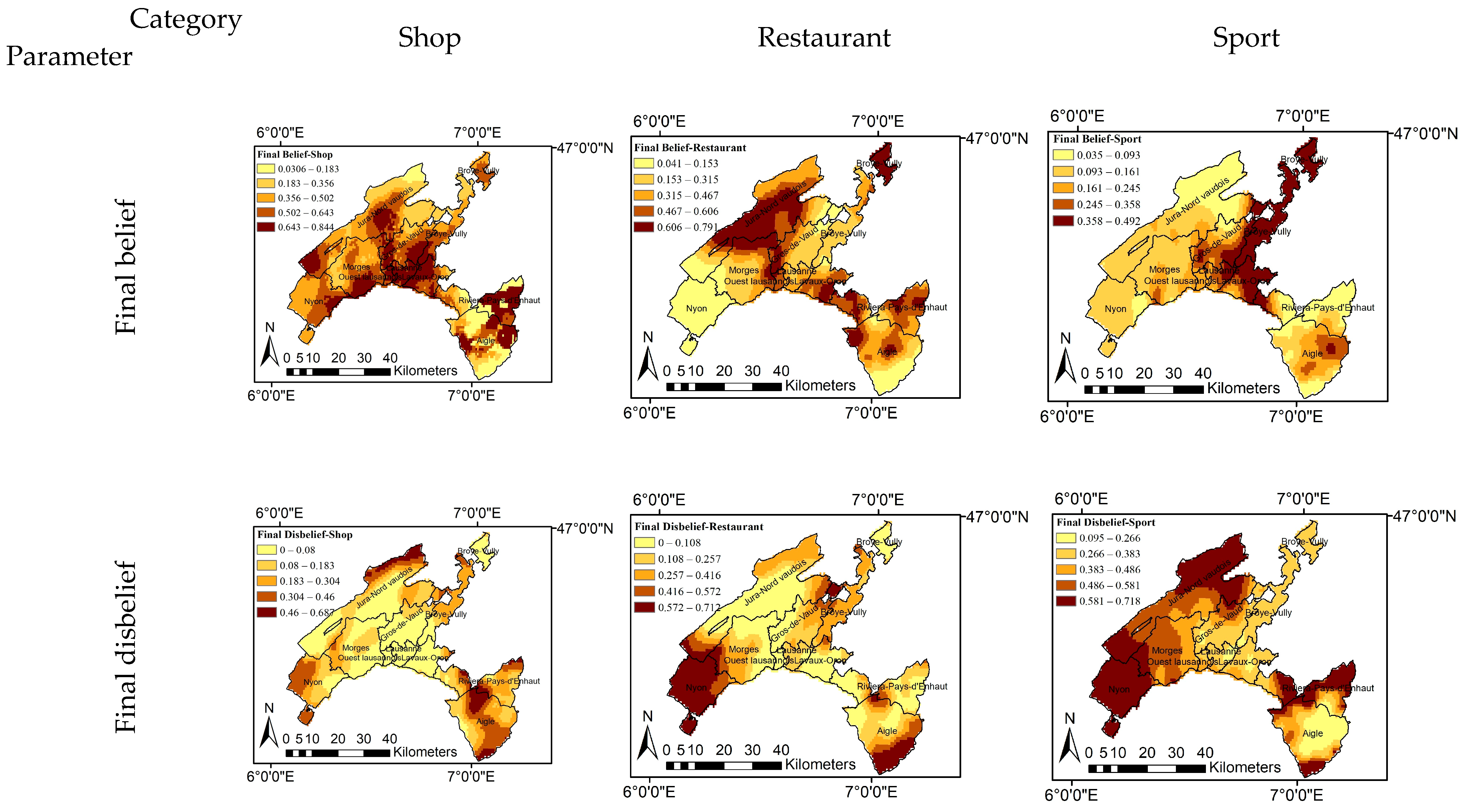Assessing Spatial Accessibility Uncertainty with Dempster–Shafer Theory: A Comparison of Potential and Revealed Accessibility
Abstract
1. Introduction
- By addressing the uncertainty in identifying regions with high and low accessibility;
- By developing a method to calculate revealed accessibility using individuals’ trajectory data;
- By proposing a framework to compare and integrate potential accessibility with revealed accessibility for supply centers.
2. Research Basics and Background
2.1. Defining and Measuring Spatial Accessibility
- Infrastructure-based measures evaluate transport system performance, such as travel speeds or congestion levels, providing insights into system efficiency.
- Location-based measures focus on spatial distribution, using cumulative opportunity or gravity models to capture access dynamics. Cumulative models count the number of opportunities within a defined threshold, while gravity models dynamically weight opportunities based on travel impedance, offering a more nuanced depiction of spatial interactions [5,24].
- Person-based measures examine accessibility through individual constraints, such as time budgets and activity schedules. This approach offers a more granular perspective by capturing how temporal and spatial constraints shape accessibility [25].
- Utility-based measures incorporate user preferences and economic principles like consumer surplus, linking accessibility to user satisfaction and choice behavior. These measures emphasize the economic and subjective dimensions of accessibility, enabling a better understanding of how individuals perceive and benefit from available services [26].
- Distance to the nearest supply center: This straightforward approach calculates accessibility based on proximity, using metrics like Euclidean or road network-based travel time distances [9].
- Number of supply centers within a specified travel time: This method accounts for the density of service provision within a reachable distance, reflecting urban accessibility dynamics [8].
- Supply–demand balance: This ratio-based method evaluates the distribution balance between supply and demand centers within defined geographic areas [27]. However, it may oversimplify the interaction dynamics between different centers.
- Cumulative Opportunity Models: These models assess accessibility by counting the number of opportunities (e.g., jobs or services) within a specified distance or travel time. They are effective for identifying local disparities, and particularly useful in urban areas [28]. However, they do not account for opportunity attractiveness (e.g., size or capacity) or the declining influence of distance beyond the threshold. Despite these limitations, they remain a practical tool for local analyses [8].
- Gravity models: Gravity models dynamically measure accessibility by weighting opportunities based on their attractiveness (e.g., size or capacity) and the cost of travel, such as distance or time. They include decay functions, like exponential or power decay, to reflect the decreasing influence of accessibility as distance increases [5,8]. Unlike cumulative models, gravity models capture broader spatial interactions, enabling detailed regional or national analyses. Enhanced versions, such as those accounting for competition among demand locations and prioritizing closer supply centers, provide a comprehensive view of accessibility by linking proximity with population size [14,24].
2.2. Potential Versus Revealed Accessibility
2.3. Uncertainty in Spatial Accessibility and the Role of DST
Theoretical Foundation of DST in Spatial Accessibility
3. Methodology
3.1. Potential Accessibility Map
3.2. Revealed Accessibility Map
3.3. DST in Spatial Accessibility Framework and Hypotheses
3.3.1. Framework and Hypotheses
3.3.2. Mass Function and Belief Calculations
3.3.3. Spatial Implementation of DST
3.3.4. Membership Functions for Accessibility Evaluation
3.4. Potential and Revealed Accessibility Maps
4. Data and Study Area
4.1. MDC
4.2. OSM
5. Results and Discussion
6. Conclusions
Author Contributions
Funding
Data Availability Statement
Acknowledgments
Conflicts of Interest
References
- The United Nations Department of Economic and Social Affairs (UN DESA). World Urbanization Prospects, The 2014 Revision; United Nations: New York, NY, USA, 2014. [Google Scholar]
- Van Maarseveen, M.; Martinez, J.; Flacke, J. GIS in Sustainable Urban Planning and Management: A Global Perspective; Taylor & Francis: Abingdon, UK, 2019. [Google Scholar]
- Wang, F.; Luo, W. Assessing spatial and nonspatial factors for healthcare access: Towards an integrated approach to defining health professional shortage areas. Health Place 2005, 11, 131–146. [Google Scholar] [CrossRef] [PubMed]
- Ashik, F.R.; Mim, S.A.; Neema, M.N. Towards vertical spatial equity of urban facilities: An integration of spatial and aspatial accessibility. J. Urban Manag. 2020, 9, 77–92. [Google Scholar] [CrossRef]
- Park, J.; Goldberg, D.W. A review of recent spatial accessibility studies that benefitted from advanced geospatial information: Multimodal transportation and spatiotemporal disaggregation. ISPRS Int. J. Geo-Inf. 2021, 10, 532. [Google Scholar] [CrossRef]
- Geurs, K.T.; Van Wee, B. Accessibility evaluation of land-use and transport strategies: Review and research directions. J. Transp. Geogr. 2004, 12, 127–140. [Google Scholar] [CrossRef]
- Hewko, J.; Smoyer-Tomic, K.E.; Hodgson, M.J. Measuring neighbourhood spatial accessibility to urban amenities: Does aggregation error matter? Environ. Plan. A 2002, 34, 1185–1206. [Google Scholar] [CrossRef]
- Guagliardo, M.F. Spatial accessibility of primary care: Concepts, methods and challenges. Int. J. Health Geogr. 2004, 3, 3. [Google Scholar] [CrossRef]
- Apparicio, P.; Abdelmajid, M.; Riva, M.; Shearmur, R. Comparing alternative approaches to measuring the geographical accessibility of urban health services: Distance types and aggregation-error issues. Int. J. Health Geogr. 2008, 7, 7. [Google Scholar] [CrossRef]
- Smoyer-Tomic, K.E.; Hewko, J.N.; Hodgson, M.J. Spatial accessibility and equity of playgrounds in Edmonton, Canada. Can. Geogr./Géographies Can. 2004, 48, 287–302. [Google Scholar] [CrossRef]
- Smoyer-Tomic, K.E.; Spence, J.C.; Amrhein, C. Food deserts in the prairies? Supermarket accessibility and neighborhood need in Edmonton, Canada. Prof. Geogr. 2006, 58, 307–326. [Google Scholar] [CrossRef]
- Janatabadi, F.; Newing, A.; Ermagun, A. Social and spatial inequalities of contemporary food deserts: A compound of store and online access to food in the United Kingdom. Appl. Geogr. 2024, 163, 103184. [Google Scholar] [CrossRef]
- Rao, Y.; Zhong, Y.; He, Q.; Dai, J. Assessing the Equity of Accessibility to Urban Green Space: A Study of 254 Cities in China. Int. J. Environ. Res. Public Health 2022, 19, 4855. [Google Scholar] [CrossRef]
- Wang, L. Immigration, ethnicity, and accessibility to culturally diverse family physicians. Health Place 2007, 13, 656–671. [Google Scholar] [CrossRef] [PubMed]
- Wang, J.; Du, F.; Huang, J.; Liu, Y. Access to hospitals: Potential vs. observed. Cities 2020, 100, 102671. [Google Scholar] [CrossRef]
- Lin, S.-J.; Crawford, S.Y.; Salmon, J.W. Potential access and revealed access to pain management medications. Soc. Sci. Med. 2005, 60, 1881–1891. [Google Scholar] [CrossRef]
- Pot, F.J.; van Wee, B.; Tillema, T. Perceived accessibility: What it is and why it differs from calculated accessibility measures based on spatial data. J. Transp. Geogr. 2021, 94, 103090. [Google Scholar] [CrossRef]
- Chen, B.Y.; Yuan, H.; Li, Q.; Wang, D.; Shaw, S.-L.; Chen, H.-P.; Lam, W.H. Measuring place-based accessibility under travel time uncertainty. Int. J. Geogr. Inf. Sci. 2017, 31, 783–804. [Google Scholar] [CrossRef]
- Schiewe, J.; Knura, M. Consideration of uncertainty information in accessibility analyses for an effective use of urban infrastructures. ISPRS Int. J. Geo-Inf. 2021, 10, 171. [Google Scholar] [CrossRef]
- Conway, M.W.; Byrd, A.; Van Eggermond, M. Accounting for uncertainty and variation in accessibility metrics for public transport sketch planning. J. Transp. Land Use 2018, 11, 541–558. [Google Scholar] [CrossRef]
- Hansen, W.G. How accessibility shapes land use. J. Am. Inst. Plan. 1959, 25, 73–76. [Google Scholar] [CrossRef]
- Dalvi, M.Q.; Martin, K. The measurement of accessibility: Some preliminary results. Transportation 1976, 5, 17–42. [Google Scholar] [CrossRef]
- Patterson, Z.; Farber, S. Potential path areas and activity spaces in application: A review. Transp. Rev. 2015, 35, 679–700. [Google Scholar] [CrossRef]
- O’Kelly, M.E.; Horner, M.W. Aggregate accessibility to population at the county level: US 1940–2000. J. Geogr. Syst. 2003, 5, 5–23. [Google Scholar] [CrossRef]
- Miller, E.J. Accessibility: Measurement and application in transportation planning. Transp. Rev. 2018, 38, 551–555. [Google Scholar] [CrossRef]
- Van Wee, B. Accessible accessibility research challenges. J. Transp. Geogr. 2016, 51, 9–16. [Google Scholar] [CrossRef]
- Dai, D.; Wang, F. Geographic disparities in accessibility to food stores in southwest Mississippi. Environ. Plan. B Plan. Des. 2011, 38, 659–677. [Google Scholar] [CrossRef]
- Wu, H.; Levinson, D. Unifying access. Transp. Res. Part D Transp. Environ. 2020, 83, 102355. [Google Scholar] [CrossRef]
- Radke, J.; Mu, L. Spatial decompositions, modeling and mapping service regions to predict access to social programs. Geogr. Inf. Sci. 2000, 6, 105–112. [Google Scholar] [CrossRef]
- Luo, W.; Wang, F. Measures of spatial accessibility to health care in a GIS environment: Synthesis and a case study in the Chicago region. Environ. Plan. B Plan. Des. 2003, 30, 865–884. [Google Scholar] [CrossRef]
- Luo, W.; Qi, Y. An enhanced two-step floating catchment area (E2SFCA) method for measuring spatial accessibility to primary care physicians. Health Place 2009, 15, 1100–1107. [Google Scholar] [CrossRef]
- Khan, A.A.; Bhardwaj, S.M. Access to health care: A conceptual framework and its relevance to health care planning. Eval. Health Prof. 1994, 17, 60–76. [Google Scholar] [CrossRef]
- Páez, A.; Scott, D.M.; Morency, C. Measuring accessibility: Positive and normative implementations of various accessibility indicators. J. Transp. Geogr. 2012, 25, 141–153. [Google Scholar] [CrossRef]
- Casas, I.; Delmelle, E.; Delmelle, E.C. Potential versus revealed access to care during a dengue fever outbreak. J. Transp. Health 2017, 4, 18–29. [Google Scholar] [CrossRef]
- Lättman, K.; Olsson, L.E.; Friman, M. A new approach to accessibility–Examining perceived accessibility in contrast to objectively measured accessibility in daily travel. Res. Transp. Econ. 2018, 511–501, 69. [Google Scholar] [CrossRef]
- Lättman, K.; Olsson, L.E.; Friman, M. Development and test of the perceived accessibility scale (PAC) in public transport. J. Transp. Geogr. 2016, 54, 257–263. [Google Scholar] [CrossRef]
- Friman, M.; Lättman, K.; Olsson, L.E. Public transport quality, safety, and perceived accessibility. Sustainability 2020, 12, 3563. [Google Scholar] [CrossRef]
- Hunter, G.J.; Goodchild, M. Managing uncertainty in spatial databases: Putting theory into practice. URISA J. 1993, 5, 55–62. [Google Scholar]
- Batty, M. Unpredictability. Environ. Plan. B Urban Anal. City Sci. 2020, 47, 739–744. [Google Scholar] [CrossRef]
- Dempster, A.P. Upper and lower probabilities induced by a multivalued mapping. Ann. Math. Stat. 1967, 325–339. [Google Scholar] [CrossRef]
- Shafer, G. A Mathematical Theory of Evidence; Princeton University Press: Princeton, NJ, USA, 1976; Volume 1. [Google Scholar]
- Montoliu, R.; Gatica-Perez, D. Discovering human places of interest from multimodal mobile phone data. In Proceedings of the 9th International Conference on Mobile and Ubiquitous Multimedia, Limassol, Cyprus, 1–3 December 2010; p. 12. [Google Scholar]
- Shi, W. Principles of Modeling Uncertainties in Spatial Data and Spatial Analyses; CRC Press: Boca Raton, FL, USA, 2009. [Google Scholar]
- Zadeh, L.A. Fuzzy sets. Inf. Control 1965, 8, 338–353. [Google Scholar] [CrossRef]
- Mogaji, K.; Lim, H.; Abdullah, K. Regional prediction of groundwater potential mapping in a multifaceted geology terrain using GIS-based Dempster–Shafer model. Arab. J. Geosci. 2015, 8, 3235–3258. [Google Scholar] [CrossRef]
- Laurila, J.K.; Gatica-Perez, D.; Aad, I.; Bornet, O.; Do, T.-M.-T.; Dousse, O.; Eberle, J.; Miettinen, M. The mobile data challenge: Big data for mobile computing research. In Proceedings of the Pervasive Computing, Newcastle, UK, 18–22 June 2012. [Google Scholar]


















| Category | Shop | Restaurant | Sport |
|---|---|---|---|
| Parameter | |||
| Mean potential | 0.149 | 0.036 | 0.03 |
| Std. potential | 0.17930 | 0.0783 | 0.11287 |
| Mean revealed | 0.134 | 0.23 | 0.151 |
| Std. revealed | 0.06208 | 0.10161 | 0.0792 |
| Supply Category | Population Under Supply Shortage | Area of Shortage Area (km2) | Percentage of Shortage Area (%) |
|---|---|---|---|
| Shop | 2948 | 146.0662 | 9.3 |
| Restaurant | 74,212 | 439.2962 | 28 |
| Sport | 151,767 | 984.9006 | 62.7 |
Disclaimer/Publisher’s Note: The statements, opinions and data contained in all publications are solely those of the individual author(s) and contributor(s) and not of MDPI and/or the editor(s). MDPI and/or the editor(s) disclaim responsibility for any injury to people or property resulting from any ideas, methods, instructions or products referred to in the content. |
© 2025 by the authors. Published by MDPI on behalf of the International Society for Photogrammetry and Remote Sensing. Licensee MDPI, Basel, Switzerland. This article is an open access article distributed under the terms and conditions of the Creative Commons Attribution (CC BY) license (https://creativecommons.org/licenses/by/4.0/).
Share and Cite
Esmaeili Tajabadi, R.; Pahlavani, P.; Hosseinpoor Milaghardan, A.; Claramunt, C. Assessing Spatial Accessibility Uncertainty with Dempster–Shafer Theory: A Comparison of Potential and Revealed Accessibility. ISPRS Int. J. Geo-Inf. 2025, 14, 370. https://doi.org/10.3390/ijgi14100370
Esmaeili Tajabadi R, Pahlavani P, Hosseinpoor Milaghardan A, Claramunt C. Assessing Spatial Accessibility Uncertainty with Dempster–Shafer Theory: A Comparison of Potential and Revealed Accessibility. ISPRS International Journal of Geo-Information. 2025; 14(10):370. https://doi.org/10.3390/ijgi14100370
Chicago/Turabian StyleEsmaeili Tajabadi, Roya, Parham Pahlavani, Amin Hosseinpoor Milaghardan, and Christophe Claramunt. 2025. "Assessing Spatial Accessibility Uncertainty with Dempster–Shafer Theory: A Comparison of Potential and Revealed Accessibility" ISPRS International Journal of Geo-Information 14, no. 10: 370. https://doi.org/10.3390/ijgi14100370
APA StyleEsmaeili Tajabadi, R., Pahlavani, P., Hosseinpoor Milaghardan, A., & Claramunt, C. (2025). Assessing Spatial Accessibility Uncertainty with Dempster–Shafer Theory: A Comparison of Potential and Revealed Accessibility. ISPRS International Journal of Geo-Information, 14(10), 370. https://doi.org/10.3390/ijgi14100370







